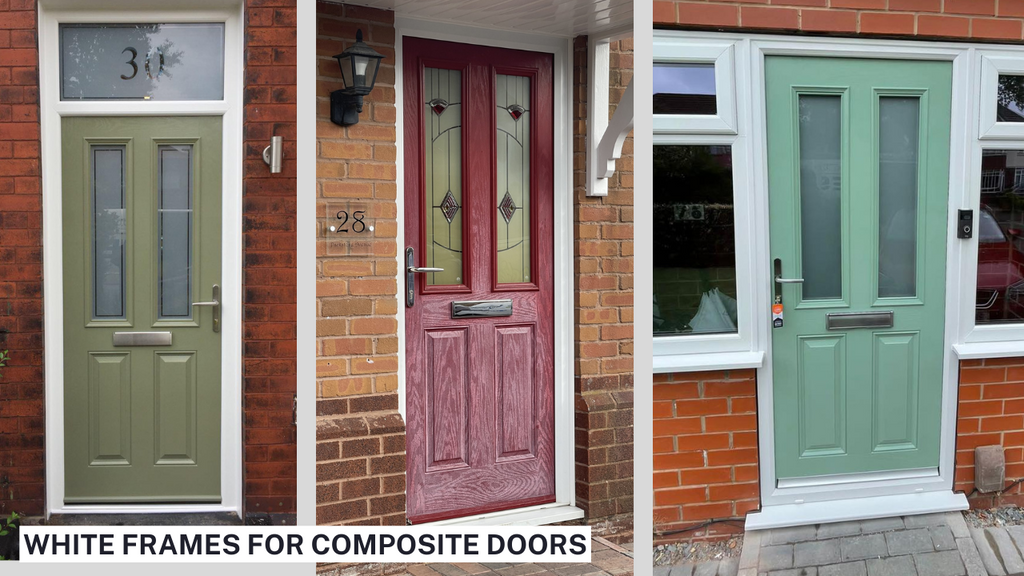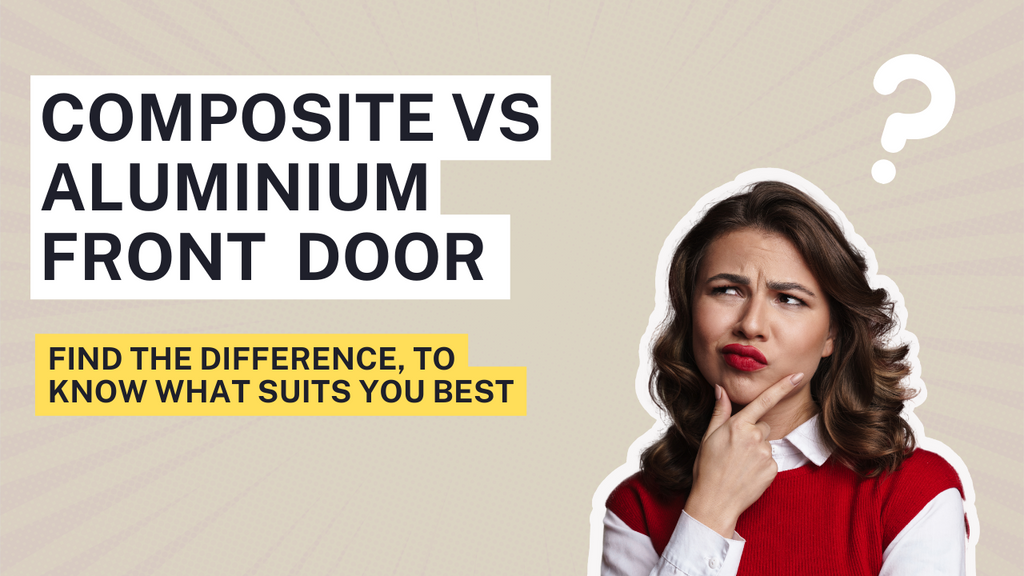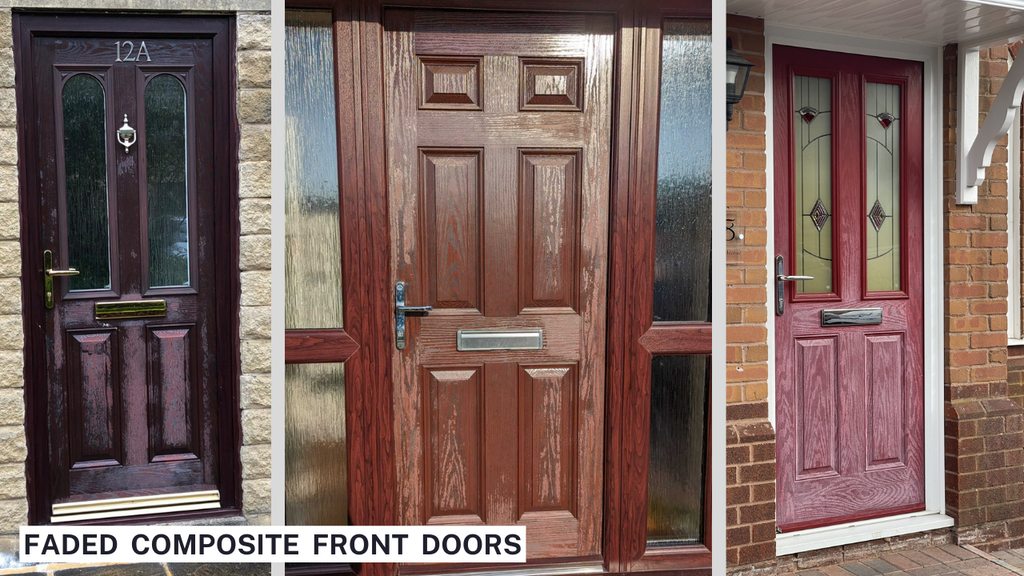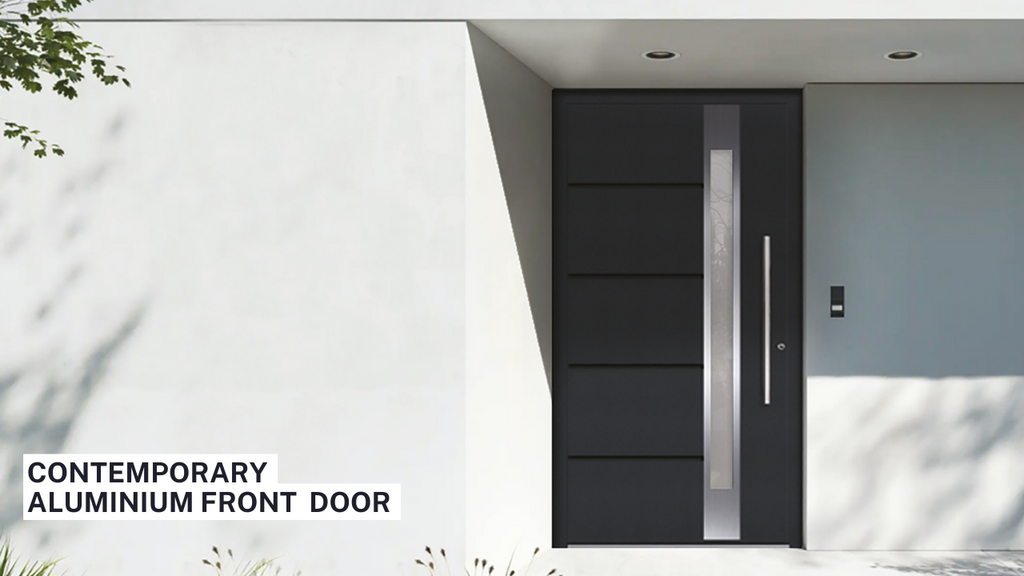Introduction
A front door to any house is impressionable, it can make your home stand out on the street, but that is not all that the front door does. It must provide security and thermal efficiency too besides making the entrance to any house attractive. With the rising energy bills, the front door must be energy-saving and draught-proof. Above all the front door must keep the residents safe and secure and should have anti burglary security systems in place.
Composite and Aluminium Front Doors are gaining popularity in the market of late due to various reasons. Though the Aluminium Doors are fairly new to the market, around 7-8 years old, the composite doors have been in the industry longer. In this article, we will learn about these in detail and compare the two to see which is a better and safer choice for your home.
Understanding Composite Front Doors
Composition and Construction of Composite Front Doors
A composite door as the name suggests is made of various materials, including uPVC, wood, insulating foam and GRP (Glass Reinforced Plastic). The core of the composite front door leaf is generally made of a timber frame with an insulating foam infill panel, while the skin of the composite door is made of GRP. Better quality composite front doors have a solid timber core. The door has a hidden sash, giving it a flush door look with only single frame being visible.
However, the frame of the composite door is mostly made of uPVC by system companies like Rehau, Kommerling, Deceuninck, Spectus and others. These frames have welded construction. As the uPVC doors have been in the market for a very long time, there are numerous uPVC manufacturers in the industry as compared to Aluminium Door manufacturers. It is fairly easy for them to source a composite door slab from either Korea or China or sometimes by a UK supplier too and make the door frame inhouse using a uPVC frame to supply a composite front door to an end customer.
The combination of these materials results in a door that is very strong and secure, aesthetically pleasing and easy to maintain. However, due to its construction in timber it is liable to warp, swell and bow.

Picture Credit: Comp Door Website
Advantages of composite front doors
-
Insulation properties
Most composite front doors in the market meet the building regulation standards for thermal insulation in the UK.
-
Strength and security
The composite main doors come equipped with multipoint locking systems and secured cylinders offering secure doors to the customers.
-
Aesthetics and design versatility
These doors have more of a traditional look and have a wood effect texture, available in limited colours. As the uPVC door frames are sourced from system companies and the door slab is sourced from another supplier, usually in China or Korea, the colour consistency is lacking in these doors. However, these are easy to maintain as unlike timber doors these do not require regular painting and polishing.
Considerations when choosing Composite Front Doors
-
Cost Effectiveness
The cost of the composite door will vary depending on the core of the door. Doors with a solid timber core are more expensive than the ones with a timber framework infilled with an EPS insulation panel. There are very few companies in the market that make good quality solid timber core composite doors and these doors are sometimes even more expensive than Aluminium Front Doors. However, generally speaking, these doors range in price from £1000 to £2500 excluding VAT and fitting is additional.
-
Maintenance
The composite main doors are made of GRP skin and these are easy to maintain. They can be wiped clean with a damp cloth and unlike wooden doors do not require painting every now and then. But these tend to warp and bow as they are made of timber, causing issues like draught and making the door hard to lock.
Moreover, the door colour if a dark one, tends to fade if not protected by the sun using a canopy or a sun shade.
-
Lead Times
The simple door design, with welded frame construction, makes these doors quick to manufacture. Most uPVC window manufacturers in the UK can easily produce these by sourcing the door frames from system companies like Rehau, Kommerling, Deceuninck, Spectus etc. and sourcing the door slabs from China or Korea to make the composite front door for the end customer. Hence, these have shorter lead times as compared to aluminium doors.
Common Issues with Composite Front Doors
Though known for their durability and low maintenance, composite front doors can encounter the following problems in due course of time:
Warp, Bow and Swell
Like traditional wooden doors, composite doors also tend to warp, bow or swell due to temperature fluctuations, humidity and exposure to sunlight as these also have a timber core. This causes movement in the door leading to difficulty in closing or opening the door. In case the door bows more than 7mm and the gap becomes too big, it will need to be rectified by adjusting the hinges or in the worst cases replacing the frame.
Fading
Though good quality composite doors are generally UV resistant, however, these tend to fade over time due to exposure to direct, especially dark-coloured composite doors. This is mostly an aesthetic concern but this cannot be rectified as unlike traditional timber doors, the composite front doors can’t be re-painted.
Picture Credit: Web Search
Draughts
Due to their tendency to warp and bow, the composite doors are prone to develop draughts over time. Failing weather seals can also aid in this problem. If the problem can’t be resolved by adjusting the hinges and frame or replacing the weather strips, the entire door might need replacing.
Sticking locks
Sticking locks is another common problem with composite doors. Several factors like warping of the door, misaligned hinges or rusting locks can cause this.
Door Handles
Firstly, 99% of the composite doors come with a lever handle inside and outside. The lever handle on the external façade is not a very secure option as it has a plate which can be easily removed to unscrew the handle to completely remove it and access the cylinder to undermine the lock. Moreover, it is extremely simple to snap the lever handle. Doors with lever handles on the outside do not pass the security certification tests like PASS 24.
With the Bar Handles gaining popularity, everyone wants these on their front door. The local uPVC windows and door fabricators are making the composite front doors in-house sourcing the composite door slab and the uPVC frames from different suppliers. However, the door slabs sourced do not come with integrated handles. A bar handle is installed at a later date by the uPVC door manufacturer by drilling holes in the door slab. Now to hide the screws holding this bar handle on the rear face of the door, these door manufacturers install another bar handle indoors too. However, this is only a pull handle and cannot be used to engage and disengage the lock, so for this reason, a thumb turn is provided indoors. Unlike the lever door handle used in most aluminium doors internally, to open this cheaply made composite door one has to use both hands, one to unlock the door and the other to pull the door open. They mislead the customer by highlighting the use of a bar handle internally as a plus point while this is actually a bad design.
White Door Frame
Most door manufacturers of composite front doors only offer white-coloured door frames with contrasting door colours, especially for bright door colours like red, blue, green etc. Some of them might be able to do the door frames in the same colour as the door but only in limited colours like RAL 7016, anthracite grey colour and black colour. This is because the door frames in the composite doors are made of uPVC and these are readily available in white only. In most cases the door manufacturers produce the door frames in the same colour as the door using a thin film on the white frames to colour these in the same colour as the door, and this film is available only in limited colours - anthracite grey and black. Any scratches on the door frame with this film cannot be rectified, leading to the replacement of the frames as the only option.

Picture Credit: CES windows
Investigating Aluminium Front Doors
Characteristics of Aluminium Front Doors
An aluminium front door as the name suggests is made of Aluminium. The core of the aluminium door leaf is made of an aluminium framework with an insulating infill panel like EPS or PU etc.; with an aluminium sheet of 1.5 to 2mm on either side of the door. The aluminium door frames in quality aluminium front doors come with thermal breaks to make them further thermally and acoustically sound with lower U-values. These are also called bonded or flush aluminium doors and are high-end luxury doors. They vary in thickness from 59mm to 90mm. The thicker the door the better thermal and acoustic value it will have and consequently will be more expensive as well.
Meanwhile, the market is also flooded with cheaper Aluminium Panel Doors. The frame here is usually, 59mm thick with a 28mm thin aluminium panel. This reduces the thermal and acoustic performance of the aluminium front door considerably as the majority of the door is only 28mm thick. Unless the customer is informed, most window and door manufacturers will sell this type of door in the name of an aluminium front door to them. The Aluminium Panel Door is not as aesthetically pleasing in appearance and quality as the bonded Aluminium Front Door.
The frames, also called profiles, used in the quality, high-end Aluminium doors are from the system companies like Reynaers and Schuco, however, local cheaper profiles are also used by the door manufacturers. Many door manufacturers use Schuco Profile with a 28mm aluminium door panel and mislead the customers, by marketing this as a Schuco Door, when in reality a Schuco Door is a high-quality bonded Aluminium Front Door that comes with a Schuco profile either 75mm or 90mm thick, a hidden sash and all accessories such as the door hinges, handles, both inside and outside handle, the threshold, all manufactured by Schuco.
Bonded Flush Aluminium Front Doors, similar to Composite Doors have a hidden sash and a flush look with just a single frame unlike the Aluminium Panel Door, where the sash is visible, giving a double frame look.
Aluminium entrance doors are a class apart, premium doors in the market, that look and feel luxurious. These come with exceptional security features and multipoint locking systems and have excellent thermal and acoustic performance, exceeding the building regulations requirements in the UK.
-
Durability and Longevity
Aluminium Front Doors are the most durable doors in the market. If maintained well they look as good as new for as long as 20-plus years. The use of durable materials such as aluminium with non-corrosive powder-coated paint makes them last for years to come.
-
Thermal and Acoustic Performance
The Aluminium Main Doors, the flush bonded aluminium doors are quite thick doors comprising of the frame and door panel of either the same or almost the same thickness, varying from 59mm to as thick as 90mm. This results in the aluminium front door having exceptional thermal and acoustic value, providing a comfortable environment indoors with no heat loss and noise pollution, making it an ideal choice for any home.
-
Pleasing Aesthetic Appeal
The sophisticated door manufacturing process, the versatility of designs and the use of coherent material, aluminium, throughout the door set creates a more luxurious-looking door compared to composite doors.
Aluminium doors are powder coated using an advanced coating process. As Aluminium is used throughout the door set the colour consistency is better in these doors. Moreover, they don’t try to replicate a wood door, although wood-effect finishes are available, these doors look and feel much better than composite doors.
-
Low maintenance requirements
Good quality powder-coated paint finish and the use of durable materials like aluminium makes the door low maintenance. These doors can be wiped clean with a soft damp cloth. The aluminium doors can be painted in textured, slightly grainy finish or smooth matt finish.
The textured finish is less prone to scratches and fingerprint marks. However, both are durable paint finishes and will only need a damp cloth to wipe these clean.
Occasional oiling of hinges and locking system with a lubricant such as WD40 can keep the door in good working condition for years to come.
-
Security
The Aluminium Front Doors are equipped with multipoint locking systems and security pins such as RC2 security pins to make these exceptionally secure. The use of Laminate glass in the glass panel further makes these difficult to break in, making these safe and secure for any house. Most Aluminium doors come with a bar handle or pull handle on the exterior façade and a lever handle internally, making it furthermore secure.
Limitations of aluminium front doors
-
Long Lead Times
The design and manufacturing process of the aluminium front doors is more sophisticated and hence leads to longer lead times than composite doors.
-
Higher Cost
Due to their robust nature, higher thermal and acoustic value and luxurious look, Aluminium Front Doors are costlier than composite doors. However, in the long run with low maintenance costs and energy-saving features, the cost is evened out.
-
Prone to scratching and denting
Aluminium Front Doors are prone to denting and scratching, however, this is an aesthetic concern and does not impact the functioning of the door. Scratches and be touched up with paint, however, dents cannot be removed easily.
TABLE OF COMPARISON BETWEEN ALUMINIUM AND COMPOSITE FRONT DOORS
Here’s a list of key differences between a composite and an aluminium front door to help you choose a front door to suit your needs and fit your budget:
|
|
COMPOSITE
|
ALUMINIUM
|
|
MATERIAL
|
A combination of timber, uPVC and GRP (Glass Reinforced Plastic) skin
|
The use of just Aluminium gives the door a sleek, consistent and contemporary look
|
|
|
|
|
|
PRICE
|
More affordable than Aluminium but can be similarly priced too, especially for quality solid timber core composite doors
|
Costlier than Composite Doors but due to low maintenance and energy efficiency the price is evened out in the long run
|
|
|
|
|
|
DESIGN
|
Replicates the Traditional timber door look in various colours and designs
|
Generally Contemporary Designs with minimalist and slimmer frames. However, traditional designs also available
|
|
|
|
|
|
THERMAL PERFORMANCE
|
Good to Excellent Thermal performance
|
Good to Excellent Thermal performance
|
|
|
|
|
|
SECURITY
|
Offer good security with multipoint locking but can warp compromising the locking security
|
Offer excellent security with RC2 security pins in addition to multipoint locking systems.
|
|
|
|
|
|
FIRE RATED
|
Can be fire rated
|
These are not fire-rated
|
|
|
|
|
|
MAINTENANCE
|
Easy to maintain provided these don’t warp, bow or fade
|
Low maintenance
|
As the aluminium front doors have gained popularity only in the recent 7 to 8 years there are still not as many Aluminium Door manufacturers in the industry as the uPVC Door manufacturers. As they can easily manufacture a composite front door by sourcing the door slab and the uPVC frames from different suppliers, they only promote composite front doors and not Aluminium Front Doors to their prospective customers looking for a front door.
However, intensive research on both doors must be done by the customers before they choose one of these options, as one would like a long-lasting front door you are happy to see day in and day out.
Here is a quick recap to help inform your decision to choose between Composite and Aluminium Front Doors:
-
Composite Front Door
For affordability, a traditional timber door look and a fire-rated door go for a Composite Front Door.
-
Aluminium Front Door
For a long-lasting modern secure door with slim profiles go for an Aluminium Door.
Finally, it boils down to one's specific needs and preferences that will shape their decision to go ahead with either of these doors. For good quality Aluminium Front Doors at competitive prices please check Glasswin Front Doors website at
www.doorwin.co.uk. or call on
0330 122 4562



 Picture Credit: CES windows
Picture Credit: CES windows 


